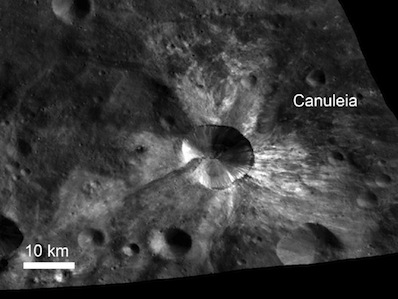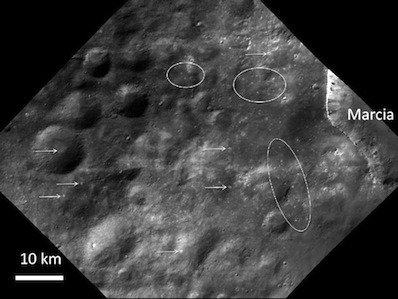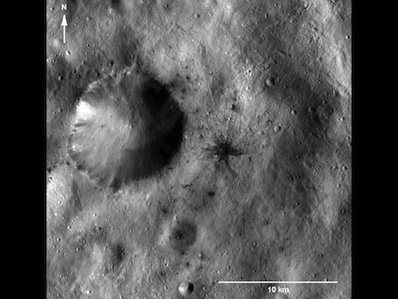
Vesta's surface of
light and dark
DR EMILY BALDWIN
ASTRONOMY NOW
Posted: 23 March 2012


New images from NASA's Dawn spacecraft have revealed unexpected details of giant asteroid Vesta's surface, including light and dark markings that have never before been seen on asteroids.

In this image from NASA's Dawn spacecraft, bright material extends out from the crater Canuleia on Vesta. Image: NASA/JPL-Caltech/UCLA/MPS/DLR/IDA/UMD.
Bright patches – some twice as bright as other regions – are found in and around craters and span regions from a hundred metres to 16 kilometres across. Bright material is typically exposed when small impactors collide with a rocky body's surface, churning up the surface to reveal relatively fresh material.
"Our analysis finds this bright material originates from Vesta and has undergone little change since the formation of Vesta over 4 billion years ago," says Dawn scientist Jian-Yang Li from the University of Maryland. "We're eager to learn more about what minerals make up this material and how the present Vesta surface came to be."

Numerous small, bright spots appear on Vesta. Image: NASA/JPL-Caltech/UCLA/MPS/DLR/IDA/UMD.
Distinct zones of darker materials were also revealed and found to be more varied in colour than expected, ranging from dark grey to shades of brown and red. Also associated with impact craters, Dawn scientists suspect that a combination of low and high speed impacts are responsible. Low speed impacts are slow enough to produce small deposits without blasting away the surface, while higher speed collisions would melt and darken the asteroid's crust more dramatically.
"Some of these past collisions were so intense they melted the surface," says Brett Denevi of the Johns Hopkins University Applied Physics Laboratory. "Dawn's ability to image the melt marks a unique find. Melting events like these were suspected, but never before seen on an asteroid."

A dark-rayed impact crater and several dark spots were seen in this view of asteroid Vesta. Image: NASA/JPL-Caltech/UCLA/MPS/DLR/IDA/ASU
Dawn has been in orbit around Vesta since July 2011 and after a year of collecting observations and data will rendezvous with spherical dwarf planet Ceres in 2015. Analysing the surfaces of these unique bodies will help scientists learn about the materials and processes that went into building our Solar System.
The new results were highlighted during the Lunar and Planetary Science Conference in Texas earlier this week.
|



